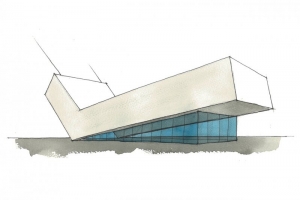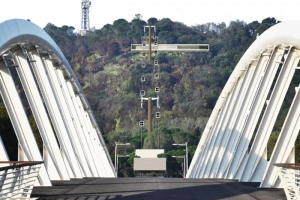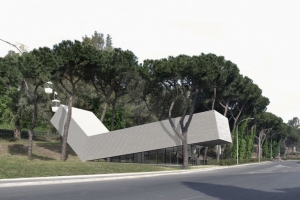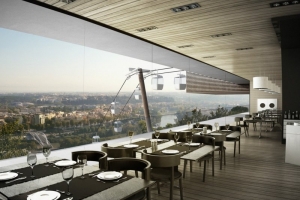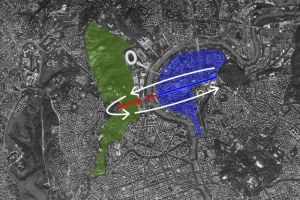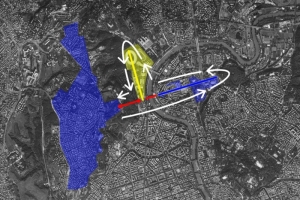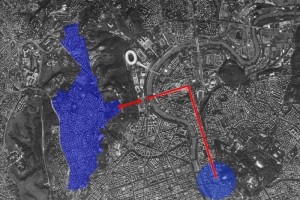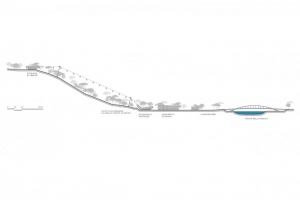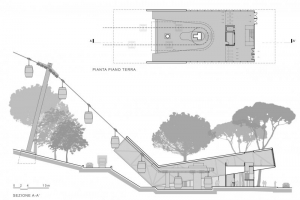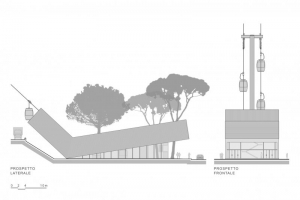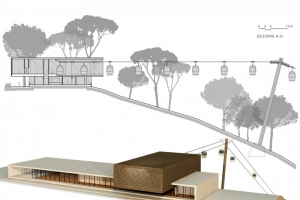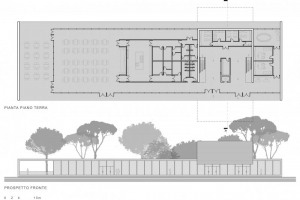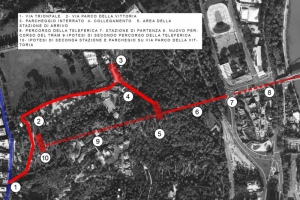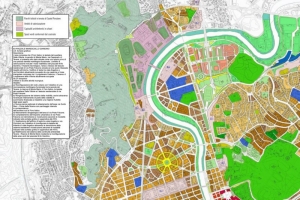MONTEMARIO’S CABLEWAY
TYPE: INFRASTRUCTURE/CABLEWAY
LOCATION: PIAZZALE MARESCIALLO GIARDINO, ROME, ITALY
PROGRAM: 320 m LONG, 116 m HIGH CABLEWAY, 2 STATIONS
DESIGN: 2013
COMPLETED: -
CLIENT: -
DESIGN TEAM: MAURIZIO GIODICE, SAEED AMIRZADEH
TEXT:
A CABLE CAR IN ROME
The Idea
The Ponte della Musica (BridgeofMusic) connects the axis of culture (Via Guido Reni) to the axis of the sport (Via delle Olimpiadi), and in essence serves to connect the Flaminio district to the Foro Italico. Yet, the bridge has remained largely unused for one simple reason: at the intersection of the two axes there is practically nothing. In fact, only the once beautiful House of Fencing by Luigi Moretti stands there, now unfortunately in such a state of disrepair, decay and neglect that it cries out for vengeance. But that’s another story.
Nonetheless, the bridge remains empty because residents have no reason to cross it. What we will describe is an idea that returns real meaning to the bridge, and at the same time solves some of the problems of mobility in the Flaminio and Trionfale neighborhoods. Our project consists of a cable car system from the base of Monte Mario, in line with theBridgeofMusic, and rising up the slope almost to the top of Monte Mario Park itself.
The cable car is much used in urban infrastructure, just think of the Montjuic Cable Car inBarcelona, or those ofLisbonorRio de Janeiro, or even the recent London Cable Car built for the Olympics. The Cableway on Monte Mario, while covering a shorter distance (only320 m) and height ( only116 m) than these, may in fact solve a greater number of problems.
The inhabitants of the Flaminio district would be able to use this cable car system to access the park on Monte Mario, a place now almost inaccessible due to the exhausting climb. Residents are thus given a real reason to walk theBridgeofMusic: to use a beautiful urban park naturalistically, one that today the city spends a lot of money to maintain, yet is unfortunately all but deserted. In addition, rising along the axis of the bridge ( as if it were an extension ), the cableway would complete the visual line between Monte Mario and the cross of Villa Glori, which is now invisible because access to the Monte Mario Park at that point is very difficult.
Additionally, all the residents of the Trionfale district would now finally be able to walk from home to the Olympic Stadium, the Tennis Stadium, the Foro Italico, the Tennis Club, and the CONI (Comitato Olimpico Nazionale Italiano). Further, using theBridgeofMusic, they would access the Olympic Theater, the MAXXI, the Stadio Flaminio, the Sports Hall and the Auditorium. To reach these places today, those very residents must drive around thepeakofMonte Mario, wasting their time stuck in traffic. And, if one decides to go to the Maxxi by public transport , it would take almost two hours on the bus, then the metro and then the tram. Using our cable-car and walking on foot through theBridgeofMusicinstead would take only ten minutes, decongesting traffic, and streamlining and beautifying pedestrian transportation.
Finally, if theBridgeofMusicwas used to connect the tram that runs along the Via Flaminia, crossing theTiberRiverand passing by Guido Reni, local Trionfale residents could reach on foot, and in a very short time the Piazza del Popolo, as well as the city center. Also, tourists visiting from the center could easily have a picnic on Monte Mario and enjoy one of the most beautiful panoramic views of the city.
The Project
Just like ski gondolas, this cable car system is equipped with a departure station, two piers and a destination station. The idea is to fix the starting station on the unused strip of land that separates Via dei Gladiatori and Via dello Stadio Olimpico, without the need to remove any pine trees. The architecture of the departure station is based on a simple strategy: it must allow for a very steep angle of the cables, so as not to interfere with traffic on the way to the Olympic Stadium. Precisely for this reason, the first pylon is placed in the strip of land that divides Via dello Stadio Olimpico from Via di Villa Madama. Thanks to the use of two piers, it is not necessary to cut down any of the trees in the path of the cabins.
We decided to arrange the arrival station in a open clearing almost free of vegetation that lies near at the top of the mountain. Incredibly, this clearing is now used as a pasture, wherein some goats love to relax peacefully on the ground in the morning to take in the sun. Due to its openness, this clearing is the hottest area of the park, and one can often see the goats while taking a walk on theBridgeofMusic.
This area can be reached from Via del Parco dellaVittoria, at the end of which there is a small piazza that could be used as a multi-story underground parking, with direct access to the cable car station.
The hillside arrival station, compared to the departure station, also does not involve the removal of existing trees, but differs from the latter in architectural terms. We propose the intersection of the station itself with a small building, linear in plan, that can contain a range of functions, such as recreational space. The architectural form is derived from the idea of efficiently managing the entire operation based on the project finances, described below.
Finally, it should be noted that adding an additional pylon is possible to transform the mountain station into an intermediate station, allowing the cable car to go over the top of Monte Mario and arrive at a third and final station. This station would be equipped with a multi-story underground car park placed directly on Via del Parco dellaVittoria.
The Development Model
The concept of this project’s financing is to find a private entity who can receive a grant from the qualified authorities to build and maintain the cable car and train, without the need for public funds from the city. The private investment returns come from managing the gondolas and recreational functions contained in the destination station. The goal is to configure a “win- win situation,” wherein all the actors involved get a benefit: the residents get access to the park, the solution to a problem of mobility and the use of new recreational and scenic spaces; the government gets the construction of new public infrastructure without having to spend public money, while managing to streamline both public transportation and street traffic; and finally the private concessionaire creates employment and profits from the investment.
The Feasibility
We developed this project in the hope that someone will seriously consider it as a viable solution, as we did with the restoration project of the piers of the former Bailey Bridge. We designed it because we believe that this architecture, and architecture in general, can be a way to find beautiful and meaningful solutions to the dysfunctions of contemporaryRome.
It is clear that, from a regulatory standpoint, a project of this kind cannot be achieved simply by the request of an architect.
The clearing which would accommodate the arrival station is within the Reserve of Monte Mario, and is therefore subject to the jurisdiction of the Region of Lazio. On the contrary, the area in which we hope to place the starting station is described in the General Plan as “spazio verde conformato al costruito” and is therefore the responsibility of City Hall.
However, the same PRG, in the Norme Tecniche di Attuazione (Standards of Technical Implementation), describes the area of Piazzale Maresciallo Giardino as within the “Scope of Use” with the following objectives:
- Reconfiguration of the urban node with the goal of reconnecting the morphological and functional link between the bank of theTiber, the Reserve of Monte Mario, the Foro Italico [...]
- Reorganization of the system of mobility [...]
- New pedestrian piazza abutting the axis of Via Guido Reni -BridgeofMusicwith underground parking access at the south of the Foro Italico.
- Redefinition of the system of environmental continuity of theTiber- Preservation of Monte Mario through reconfiguration of the green areas of the Piazza Maresciallo Giardino.
In short, it is fair to say that the urban planning tools are compatible with an intervention of this kind, provided that the various institutions share a political will to implement this intervention and find a way to communicate this.
